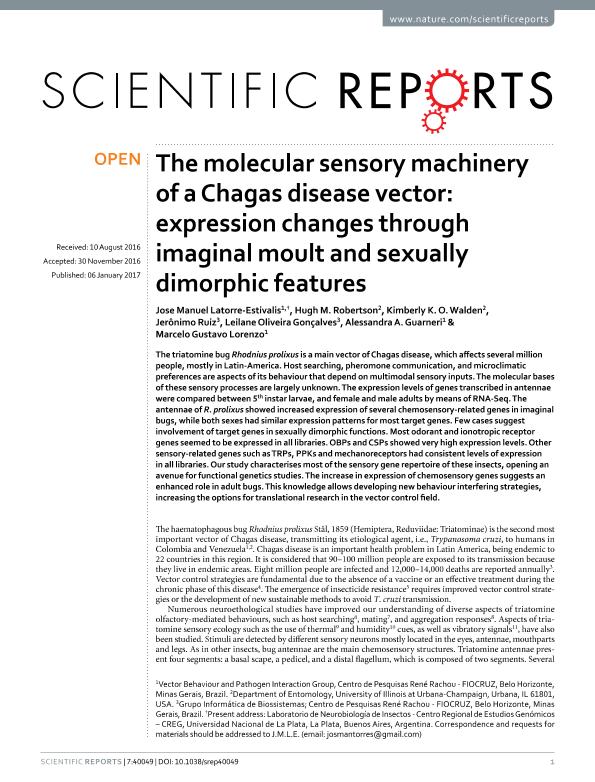Artículo
The molecular sensory machinery of a Chagas disease vector: Expression changes through imaginal moult and sexually dimorphic features
Latorre Estivalis, Jose Manuel ; Robertson, Hugh M.; Walden, Kimberly K. O.; Ruiz, Jerônimo; Oliveira Gonçalves, Leilane; Guarneri, Alessandra Aparecida; Lorenzo, Marcelo Gustavo
; Robertson, Hugh M.; Walden, Kimberly K. O.; Ruiz, Jerônimo; Oliveira Gonçalves, Leilane; Guarneri, Alessandra Aparecida; Lorenzo, Marcelo Gustavo
 ; Robertson, Hugh M.; Walden, Kimberly K. O.; Ruiz, Jerônimo; Oliveira Gonçalves, Leilane; Guarneri, Alessandra Aparecida; Lorenzo, Marcelo Gustavo
; Robertson, Hugh M.; Walden, Kimberly K. O.; Ruiz, Jerônimo; Oliveira Gonçalves, Leilane; Guarneri, Alessandra Aparecida; Lorenzo, Marcelo Gustavo
Fecha de publicación:
01/2017
Editorial:
Nature Publishing Group
Revista:
Scientific Reports
ISSN:
2045-2322
Idioma:
Inglés
Tipo de recurso:
Artículo publicado
Clasificación temática:
Resumen
The triatomine bug Rhodnius prolixus is a main vector of Chagas disease, which affects several million people, mostly in Latin-America. Host searching, pheromone communication, and microclimatic preferences are aspects of its behaviour that depend on multimodal sensory inputs. The molecular bases of these sensory processes are largely unknown. The expression levels of genes transcribed in antennae were compared between 5 th instar larvae, and female and male adults by means of RNA-Seq. The antennae of R. prolixus showed increased expression of several chemosensory-related genes in imaginal bugs, while both sexes had similar expression patterns for most target genes. Few cases suggest involvement of target genes in sexually dimorphic functions. Most odorant and ionotropic receptor genes seemed to be expressed in all libraries. OBPs and CSPs showed very high expression levels. Other sensory-related genes such as TRPs, PPKs and mechanoreceptors had consistent levels of expression in all libraries. Our study characterises most of the sensory gene repertoire of these insects, opening an avenue for functional genetics studies. The increase in expression of chemosensory genes suggests an enhanced role in adult bugs. This knowledge allows developing new behaviour interfering strategies, increasing the options for translational research in the vector control field.
Palabras clave:
Rhodnius Prolixus
,
Transcriptomica
,
Receptores Sensoriales
Archivos asociados
Licencia
Identificadores
Colecciones
Articulos(CCT - LA PLATA)
Articulos de CTRO.CIENTIFICO TECNOL.CONICET - LA PLATA
Articulos de CTRO.CIENTIFICO TECNOL.CONICET - LA PLATA
Citación
Latorre Estivalis, Jose Manuel; Robertson, Hugh M.; Walden, Kimberly K. O.; Ruiz, Jerônimo; Oliveira Gonçalves, Leilane; et al.; The molecular sensory machinery of a Chagas disease vector: Expression changes through imaginal moult and sexually dimorphic features; Nature Publishing Group; Scientific Reports; 7; 1-2017; 1-16
Compartir
Altmétricas



